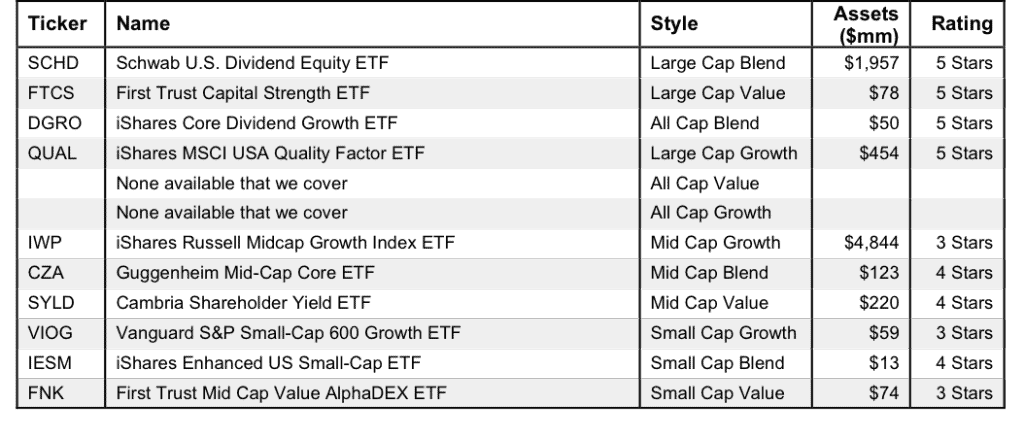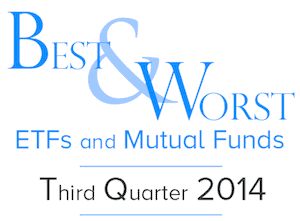Finding the best ETFs is an increasingly difficult task in a world with so many from which to choose.
You Cannot Trust ETF Labels
There are at least 47 different All Cap Blend ETFs and at least 256 ETFs across all styles. Do investors need that many choices? How different can the ETFs be?
Those 47 All Cap Blend ETFs are very different. With anywhere from 11 to 3661 holdings, many of these All Cap Blend ETFs have drastically different portfolios, creating drastically different investment implications.
The same is true for the ETFs in any other style as each offers a very different mix of good and bad stocks. Some styles have lots of good stocks and offer quality funds. The opposite is true for some styles, while others lie in between these extremes with a fair mix of good and bad stocks. For example, the All Cap Blend style, per my 3Q Style Rankings Report ranks third out of 12 styles when it comes to providing investors with quality ETFs. Large Cap Blend ranks first. Small Cap Value ranks last. Details on the Best & Worst ETFs in each style are here.
The bottom line is: ETF labels do not tell you the kind of stocks you are getting in any given ETF.
Paralysis By Analysis
I firmly believe ETFs for a given style should not all be that different. I think the large number of All Cap Blend (or any other) style of ETFs hurts investors more than it helps because too many options can be paralyzing. It is simply not possible for the majority of investors to properly assess the quality of so many ETFs. Analyzing ETFs, done with the proper diligence, is far more difficult than analyzing stocks because it means analyzing all the stocks within each ETF. As stated above, that can be as many as 3661 stocks, and sometimes even more, for one ETF.
Any investor worth his salt recognizes that analyzing the holdings of an ETF is critical to finding the best ETF.
Figure 1: Best Style ETFs
 Sources: New Constructs, LLC and company filings
Sources: New Constructs, LLC and company filings
The Danger Within
Why do investors need to know the holdings of ETFs before they buy? They need to know to be sure they do not buy a fund that might blow up. Buying a fund without analyzing its holdings is like buying a stock without analyzing its business and finances. As Barron’s says, investors should know the Danger Within. No matter how cheap, if it holds bad stocks, the ETF’s performance will be bad.
PERFORMANCE OF FUND’S HOLDINGS = PERFORMANCE OF FUND
Finding the Style ETFs with the Best Holdings
Figure 1 shows my top-rated ETF for each style. Importantly, my ratings on ETFs are based primarily on my stock ratings of their holdings. My firm covers over 3000 stocks and is known for the due diligence we do for each stock we cover. Accordingly, our coverage of ETFs leverages the diligence we do on each stock by rating ETFs based on the aggregated ratings of the stocks each ETF holds.
WisdomTree U.S. Dividend Growth (DGRW) is the top-rated All Cap Blend ETF and the overall fourth-ranked fund of the 256 style ETFs that I cover.
Sometimes, You Get What You Pay For
It is troubling to see one of the best style ETFs, First Trust Capital Strength ETF (FTCS) have just $78 million in assets despite its Very Attractive or 5-star rating. On the other hand, Neutral-rated iShares Russell Midcap Growth Index ETF (IWP) has over $4.8 billion in assets. IWP has lower total annual costs than FTCS (0.25% and 0.72% respectively), but low costs cannot drive positive performance. Quality holdings are the ultimate driver of performance.
I cannot help but wonder if investors would leave IWP if they knew that it has such a poor portfolio of stocks. It is cheaper than FTCS, but, as previously stated, low fees cannot growth wealth; only good stocks can.
Sometimes, You DON’T Get What You Pay For
iShares Enhanced US Small-Cap ETF (IESM) is one of the smallest ETFs in Figure 1 with just $13 million in assets. Sadly, other Small Cap Blend ETFs with more assets and inferior portfolios charge more than IESM. In other words, Small Cap Blend ETF investors are paying extra fees for no reason.
ProShares Ultra Russell2000 ETF (UWM) is one of the worst ETFs in the Small Cap Blend style. It gets my Dangerous rating based off the fact that less than 5% of its assets are allocated to Attractive-or-better rated stocks, while over 62% of its assets are allocated to Dangerous-or-worse stocks. UWM also has total annual costs of 1.06%, higher than IESM’s 0.4%. One would think that UWM would have fewer assets than IESM, but instead it has over $206 million. Investors are paying extra fees for poor holdings.
The worst ETF in Figure 1 is Vanguard S&P Small-Cap 600 Growth ETF (VIOG), which gets a Neutral (3 Star) rating. One would think ETF providers could do better for this style.
I recommend investors only buy ETFs with more than $100 million in assets. You can find more liquid alternatives for the other funds on my ETF screener.
Covering All The Bases, Including Costs
My ETF rating also takes into account the total annual costs, which represents the all-in cost of being in the ETF. This analysis is complex for mutual funds but straightforward for ETFs, where all costs are factored into the expense ratio. While costs play a smaller role than holdings, my ratings penalize those ETFs with abnormally high costs.
Top Stocks Make Up Top ETFs
Lockheed Martin Corp (LMT) is one of my favorite companies held by FTCS and receives my Attractive rating. Over the past decade, LMT has grown after tax profit (NOPAT) by 11% compounded annually. Over this same time frame LMT has increased its return on invested capital (ROIC) from 6% in 2003 to 11% in 2013. The company has also generated positive economic earnings every year since 2004. Despite its strong profit growth, LMT remains undervalued. LMT’s current price of ~$167/share gives it a price to economic book value (PEBV) ratio of 1.2. This ratio implies that the market expects LMT will grow NOPAT by no more than 20% over the remaining life of the company. Given LMT’s past decade of strong profit growth, this expectation seems rather pessimistic and one that LMT should surpass.
Kyle Guske II contributed to this post.
Disclosure: David Trainer and Kyle Guske II receive no compensation to write about any specific stock, style, or theme.
